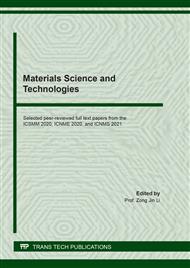[1]
B.Z. Wang, D.S. Liu, Z.X. Wen, Z.F. Yue. Tension/compression asymmetry of [001] single crystal nickel-based super-alloy DD6 during low cycle fatigue[J]. Materials Science and Engineering A. 2014;593: 31-37.
DOI: 10.1016/j.msea.2013.09.013
Google Scholar
[2]
T. Zhang, P.E. McHugh, S.B. Leen, Finite element implementation of multi-axis continuum damage mechanics for plain and fretting fatigue[J]. International Journal of Fatigue. 2012; 44(11):260-272.
DOI: 10.1016/j.ijfatigue.2012.04.011
Google Scholar
[3]
Mykola Bobyr, Holm Altenbach, Oleksandr Khalimon, On the application of the continuum damage mechanics to multi-axis low-cyclic damage[J]. Archive of Applied Mechanics. 2015; 85(4):455-468.
DOI: 10.1007/s00419-014-0922-2
Google Scholar
[4]
T. L. Anderson. Fracture mechanics:Fundamentals and applications[M].(2017).
Google Scholar
[5]
Yang Moucun, Nie Hong. Analysis Approach to Durability Based on Material Initial Fatigue Quality and S-N Curve[J]. Chinese Journal of Aeronautics. 2007; 20:518-523.
DOI: 10.1016/s1000-9361(07)60076-4
Google Scholar
[6]
M. Okazaki, M. Sakaguchi. Thermo-mechanical fatigue failure of a single crystal Ni-based single crystal super-alloy[J]. International Journal of Fatigue. 2008;30: 318–323.
DOI: 10.1016/j.ijfatigue.2007.01.044
Google Scholar
[7]
L. MOLENT. A review of equivalent pre-crack sizes in aluminium alloy 7050-T7451[J]. Fatigue Fract Engng Mater Struct. 2014; 37:1055–1074.
DOI: 10.1111/ffe.12214
Google Scholar
[8]
Manson, S.S. Behavior of materials under conditions of thermal stress[J]. National Advisory Commission on Aeronautics. 1954; Report 1170.
Google Scholar
[9]
Coffin L.F. A study of the effects of cyclic thermal stresses on a ductile metal[J]. Transactions of the American Society of Mechanical Engineers. 1954;76: 931-950.
DOI: 10.1115/1.4015021
Google Scholar
[10]
A.R. Shahani, H. Moayeri Kashani. Assessment of equivalent initial flaw size estimation methods in fatigue life prediction using compact tension specimen tests[J].Engineering Fracture Mechanics. 2013;99 : 48–61.
DOI: 10.1016/j.engfracmech.2013.01.007
Google Scholar
[11]
Andrew Makeev, Yuri Nikishkov, Erian Armanios. A concept for quantifying equivalent initial flaw size distribution in fracture mechanics based life prediction models[J].International Journal of Fatigue. 2007;29 :141-145.
DOI: 10.1016/j.ijfatigue.2006.01.018
Google Scholar
[12]
J.A.F.O. Correia, S. Blasón, A.M.P. De Jesus, et al.. Fatigue life prediction based on an equivalent initial flaw size approach and a new normalized fatigue crack growth model[J]. Engineering Failure Analysis .2016;69 :15–28.
DOI: 10.1016/j.engfailanal.2016.04.003
Google Scholar
[13]
Shankar Sankararaman, You Ling, Chris Shantz, et al.. Inference of equivalent initial flflaw size under multiple sources of uncertainty[J]. International Journal of Fatigue. 2010;32 :376–381.
DOI: 10.1016/j.ijfatigue.2010.06.008
Google Scholar
[14]
W. Steven Johnson.The history, logic and uses of the Equivalent Initial Flaw Size approach to total fatigue life prediction[J]. Fatigue 2010: Procedia Engineering. 2010; 2:47–58.
DOI: 10.1016/j.proeng.2010.03.005
Google Scholar
[15]
Zizi Lu, Yibing Xiang, Yongming Liu. Crack growth-based fatigue-life prediction using an equivalent initial flaw model. Part II: multi-axis loading[J]. International Journal of Fatigue. 2010; 32: 376–381.
DOI: 10.1016/j.ijfatigue.2009.07.013
Google Scholar
[16]
Yanqin Shangguan, Xian Wang, Yueming Li. Investigation on the mixing mechanism of single-jet film cooling with various blowing ratios based on hybrid thermal lattice Boltzmann method. International Journal of Heat and Mass Transfer. 2016;97(1): 880-890.
DOI: 10.1016/j.ijheatmasstransfer.2016.02.089
Google Scholar
[17]
Wen, Zhixun; Zhang, Dongxu; Li, Songwei. Anisotropic creep damage and fracture mechanism of nickel-base single crystal super-alloy under multi-axis stress[J]. JOURNAL OF ALLOYS AND COMPOUNDS.2017; 692: 301-312.
DOI: 10.1016/j.jallcom.2016.09.052
Google Scholar
[18]
Paris PC, Erdogan F. A critical analysis of crack propagation laws. Transactions of The ASME. Series E: Journal of Basic Engineering. 1963;85: 528-534.
DOI: 10.1115/1.3656902
Google Scholar
[19]
Mieczysław Szata, Grzegorz Lesiuk. Algorithms for the estimation of fatigue crack growth using energy method[J]. Archives Of Civil And Mechanical Engineering. 2009; IX:119-134.
DOI: 10.1016/s1644-9665(12)60045-4
Google Scholar
[20]
Plank R, Kuhn G. Fatigue crack propagation under non-proportional mixed-mode loading . Engng Fract Mech. 1999; 62:203–29.
DOI: 10.1016/s0013-7944(98)00097-6
Google Scholar
[21]
Yibing Xiang, Zizi Lu, Yongming Liu. Crack growth-based fatigue life prediction using an equivalent initial flaw model. Part I: Uniaxial loading[J].International Journal of Fatigue. 2010;32 :341–349.
DOI: 10.1016/j.ijfatigue.2009.07.011
Google Scholar
[22]
Shankar Sankararaman, You Ling, Sankaran Mahadevan.Statistical inference of equivalent initial flaw size with complicated structural geometry and multi-axis variable amplitude loading[J].International Journal of Fatigue.2010; 32: 1689–1700.
DOI: 10.1016/j.ijfatigue.2010.03.012
Google Scholar
[23]
Liu Y, Mahadevan S. A unified multi-axis fatigue damage model for isotropic and anisotropic materials. Int J Fatigue. 2007;29(2):347–59.
DOI: 10.1016/j.ijfatigue.2006.03.011
Google Scholar
[24]
Liu Y, Mahadevan S. multi-axis high-cycle fatigue criterion and life prediction for metals. Int J Fatigue. 2005;27(7):790–800.
DOI: 10.1016/j.ijfatigue.2005.01.003
Google Scholar
[25]
Liu Y, Mahadevan S. Threshold stress intensity factor and crack growth rate prediction under mixed-mode loading. Eng Fract Mech .2007;74(3):332–45.
DOI: 10.1016/j.engfracmech.2006.06.003
Google Scholar
[26]
Yongming Liu, Sankaran Mahadevan.Probabilistic fatigue life prediction using an equivalent initial flaw size distribution[J].International Journal of Fatigue.2009;31:476–487.
DOI: 10.1016/j.ijfatigue.2008.06.005
Google Scholar
[27]
Pedro M.G.P. Moreira, Paulo F.P. de Matos, Paulo M.S.T. de Castro.Fatigue striation spacing and equivalent initial flaw size in Al 2024-T3 riveted specimens[J]. Theoretical and Applied Fracture Mechanics.2005;43 :89–99.
DOI: 10.1016/j.tafmec.2004.12.005
Google Scholar
[28]
J. C. Newman, Jr. and I. S. Raju. Stress-intensity factor equations for cracks in three-imensional finite bodies[J]. NASA Langley Reseach Center, Hampton. Va 23681:1-50.
Google Scholar
[29]
Qiang Wang, Wei Zhang, Shan Jiang.Fatigue Life Prediction Based on Crack Closure and Equivalent Initial Flaw Size[J]. Materials. 2015; 8: 7145-7160.
DOI: 10.3390/ma8105367
Google Scholar


